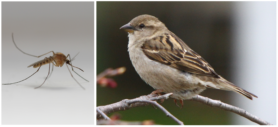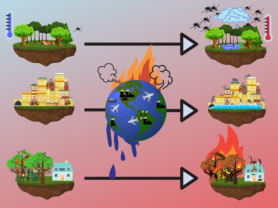Zoonoses: opening a can of worms
? Warm, warmer, sick ??⚕️
According to NOS, health care and the coronavirus have outpaced climate change in the ranking of important campaign issues in this year’s Dutch general election. “Understandably so”, you might think, considering how the small virus has drastically changed our lives during the past year. But what if I told you that even for topics such as the current pandemic and other potential zoonotic disease outbreaks, climate change plays a role? For SARS-CoV-2, the virus that causes COVID-19, a potential connection to climate change has recently been found by a team around Robert Beyer, a scientist at the Potsdam Institute for Climate Impact Research. But COVID-19 is by far not the only disease that should be mentioned here! Interested? Then make sure to keep on reading!
So what does global warming have to do with infections that are transmitted by animals to humans? There are different transmission routes for zoonotic diseases and this allows for different ways in which climate change can influence the emergence of infections.
One major mechanism is the shift or expansion of animal habitats due to changes in temperature and the water cycle. Warmer summers and milder winters cause the Netherlands – among other places – to become a more attractive home to some species that can transmit diseases. Especially ticks and mosquitoes like to live in warm and humid places.
Helen Joan Esser and Yorick Liefting from Wageningen University therefore suspect that climate change is one reason for geographic expansion of pathogens such as the West Nile virus to areas where they are not native. Indeed, 2020 was the first year in which people got infected with the West Nile virus in the Netherlands.

The common house mosquito is able to transfer the West Nile virus from a host animal to humans. The house sparrow is such a host animal. Both species live in the Netherlands.
Sea level rise and floodings are other relevant ways in which ecosystems are changing. In flooded areas, there is a much higher risk of a spreading of water-borne diseases that get transmitted by rats, for instance. Leptospirosis is an example of such a disease. It also occurs in the Netherlands.
The proximity of wild animals to humans is also important to keep in mind. Climate change can force animals to move closer to our homes. Wild animals get displaced by extreme events such as floodings and wildfires and often enough they don’t stop at the doorstep. You don’t believe that this actually happens? Just have a look at the spider invasion that is currently happening in Australia due to floodings. While the poisonous bite from these spiders does not qualify as a zoonotic disease, the potential of zoonotic infections in response to such events becomes clear and it is growing. Extreme weather events are becoming more frequent due to climate change and experts have been warning about it for decades already.
However, extreme events are not the only reason for animals to be forced to move closer to humans. In an interview with Birgitta Evengård, a professor for infectious diseases at Umeå University in Sweden, she brings up a fascinating example from the Northern countries: With decreasing presence of snow, voles are being deprived of hideaways from their predators. As an alternative, they tend to move indoors and thereby closer to humans. If their urine contains the Puumala virus, people can get sick just from inhaling air when doing something as simple as cleaning the house.

Here you can see the different ways in which climate change influences where animals find a home. The risk of catching an infectious disease from these animals is increasing with the changing climate.
You might wonder how Evengård and her team can determine if a specific disease is sensitive to the climate. Well, for some diseases this is easier to assess than for others and it all depends on the data availability. Tularemia is such a climate sensitive disease. It is transmitted by direct contact with animals but also by ingestion or inhalation of the bacteria.
Looking back in time, the disease could be identified as climate sensitive by comparing past meteorological data and the number of recorded infections. The cases of this infection are well documented, just like the weather and climate in the area, and that’s why a clear relation between both could be found. In this case, Evengård’s team was even able to correctly predict the number of infections in advance. For other diseases there are strong indications of climate sensitivity but more uncertainty due to a lack of homogeneous data. Evengård emphasizes therefore how important it is to collect data – both on infections and the weather – in a consistent way and over a long time period.
As a next step, it is of course important to understand the consequences of climate sensitive infectious diseases for the future. With the help of climate models, researchers can estimate how ecosystems will change over time and how the carrier organisms of zoonotic infections will consequently spread. It is much easier to make such predictions for the next couple of years than for the more distant future. Scientists can never be completely certain of what the climate will be in the future and how ecosystems will react. For the studies on infectious diseases, these uncertainties become more relevant on a longer time scope, especially on the regional level.
Yet, the trend is clear: Many zoonotic infectious diseases are spreading and just like other phenomena of climate change, they will hit those people the hardest who are already in vulnerable situations. The World Health Organization reported on such a relation between zoonoses and poverty already in 2006.
So is there anything that can be done about it? Luckily yes, but it requires a lot of work. We need to improve our understanding of the processes and our predictions for the future. As already mentioned, the availability of harmonized data is essential to the research in this field. Evengård thus suggests to strengthen international cooperation and to involve more ordinary people into the data collection, not only professionals. This is known as citizen science.

Regarding what we can do to improve the situation, Evengård says that “citizens have to get involved and put pressure on the politicians”.
She also points out that in a world where fake news have become ever-present, we have to stay alert and continue to watch out for the real facts. Lastly, we as a society need to be ahead of the changes to come. This means taking preventive measures such as making vaccinations for emerging infections accessible even faster. And if governments are being slow (which they often are), it is our task as citizens to put pressure on them.
Coming back to COVID-19, we see that despite the urgent problems that the pandemic brings, we must not forget about climate change – also minimize the risk of upcoming zoonotic diseases in the Netherlands and elsewhere. For you this means: Stay curious, stay informed and let your voice be heard!
Image credits:

